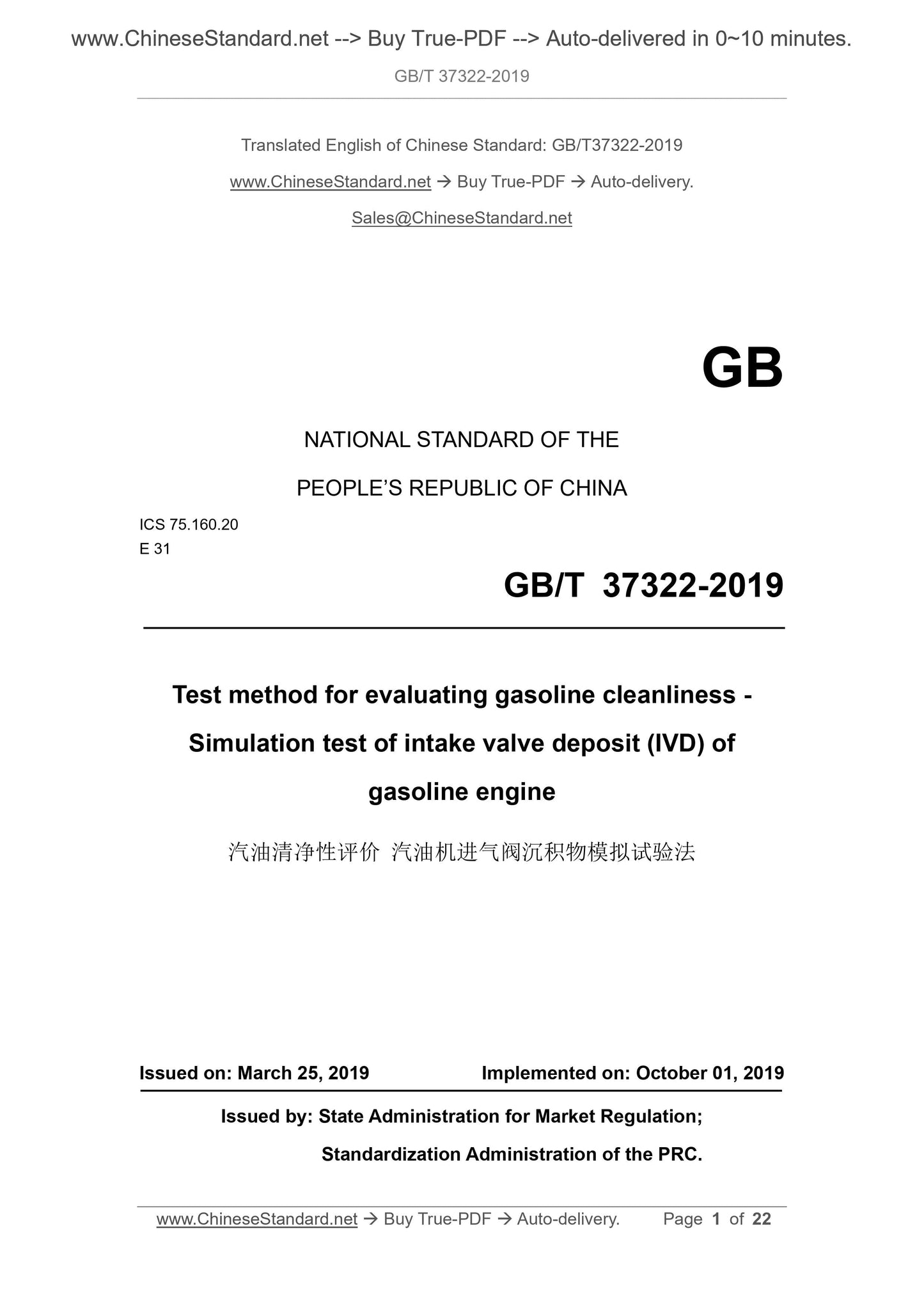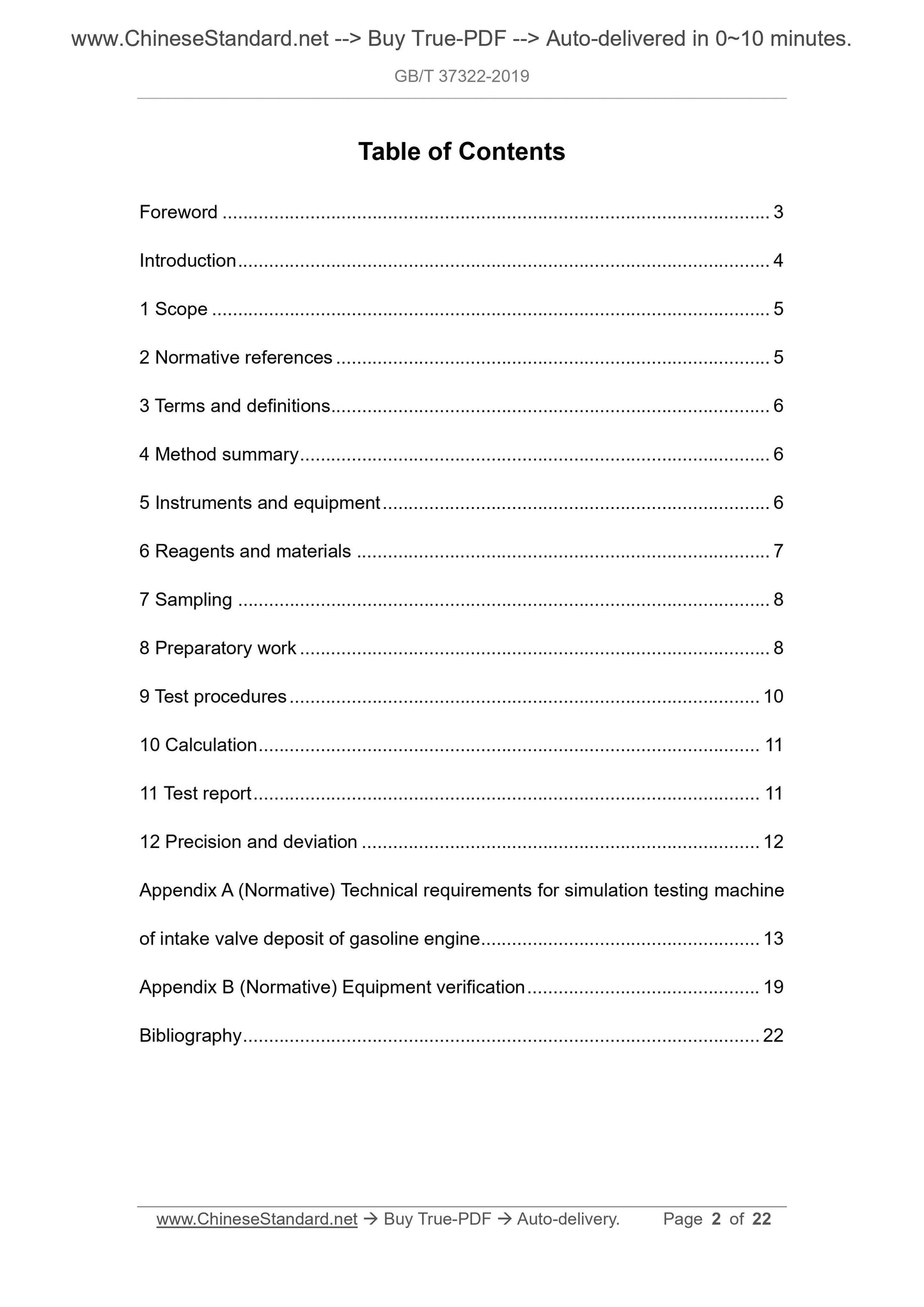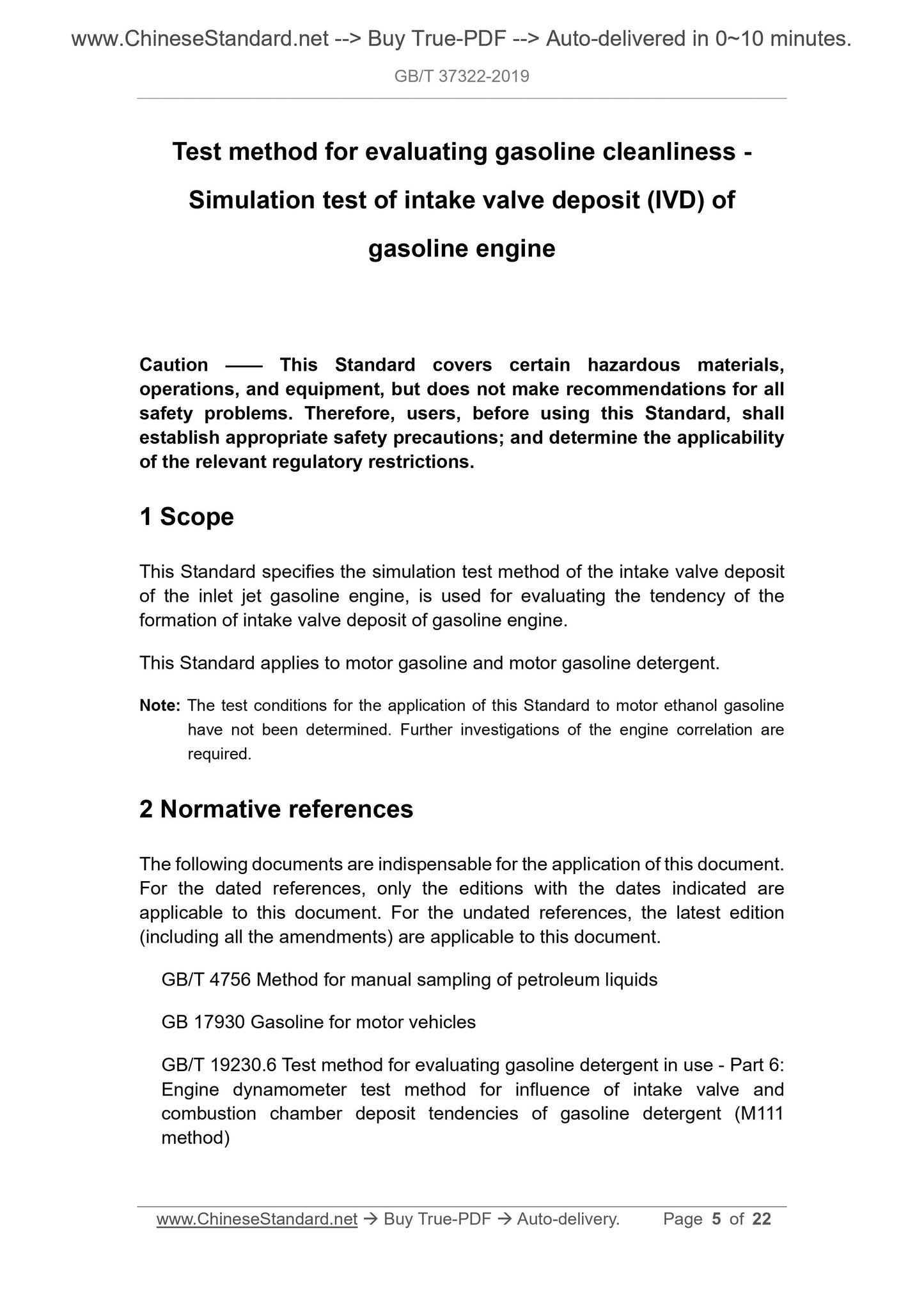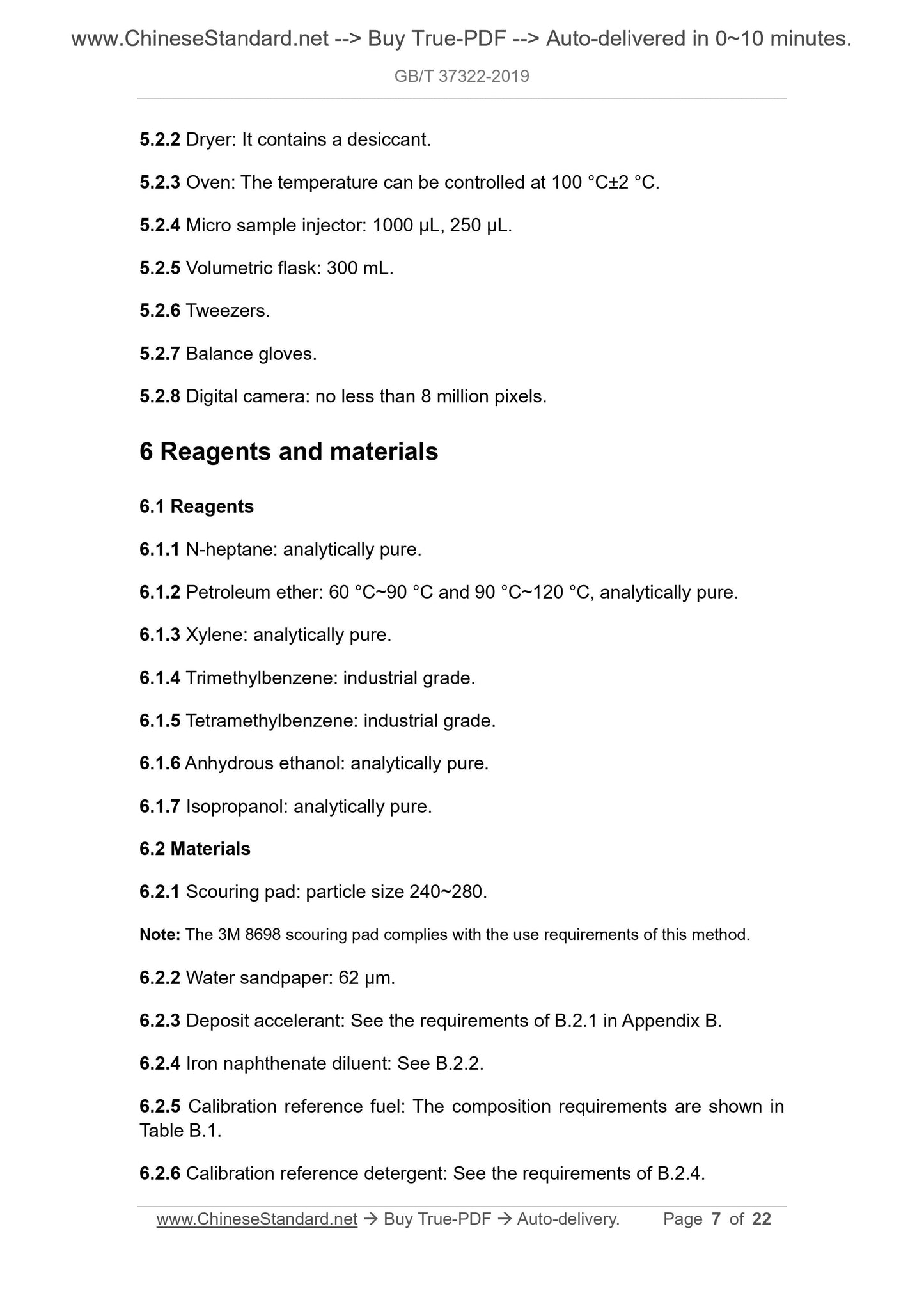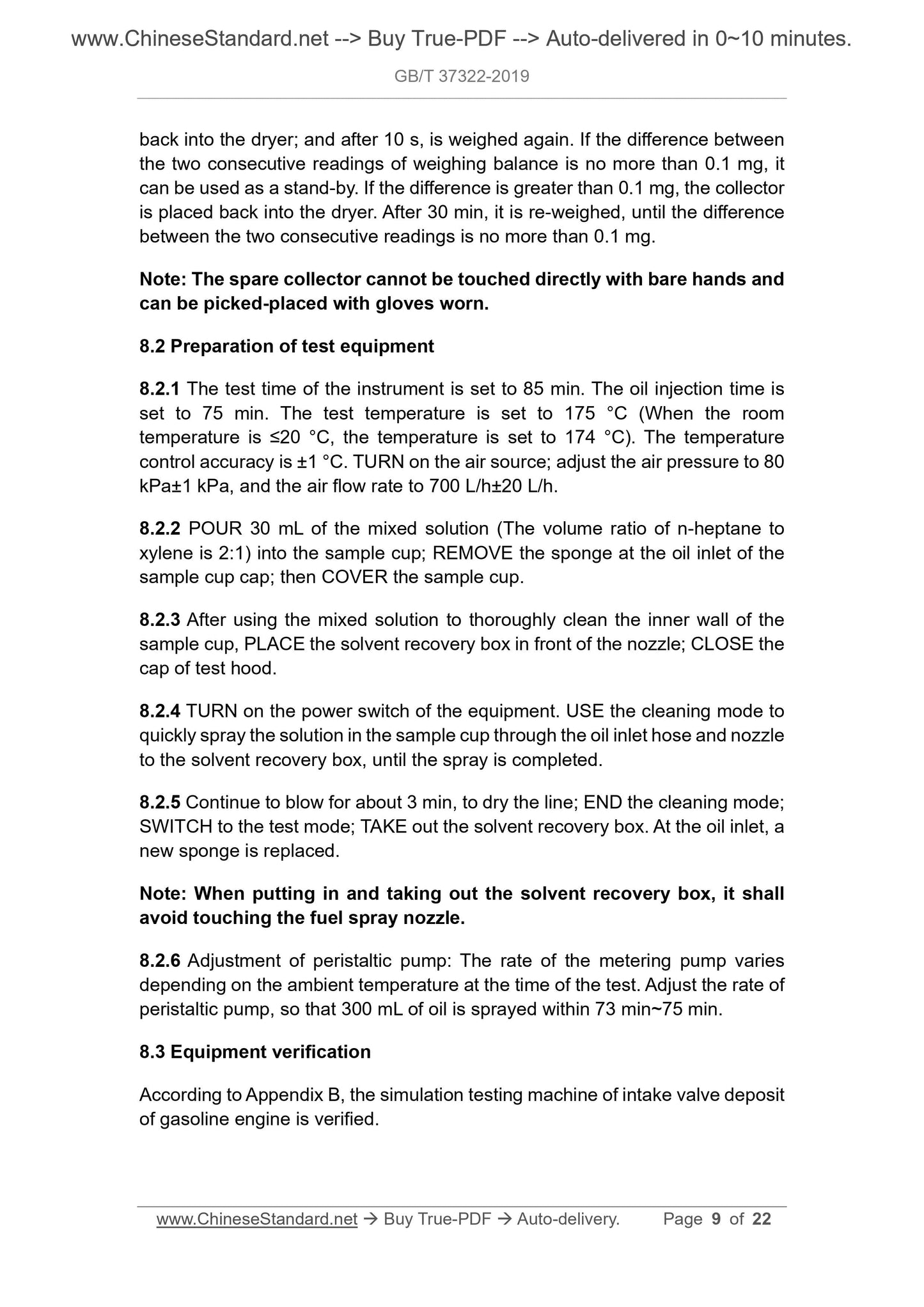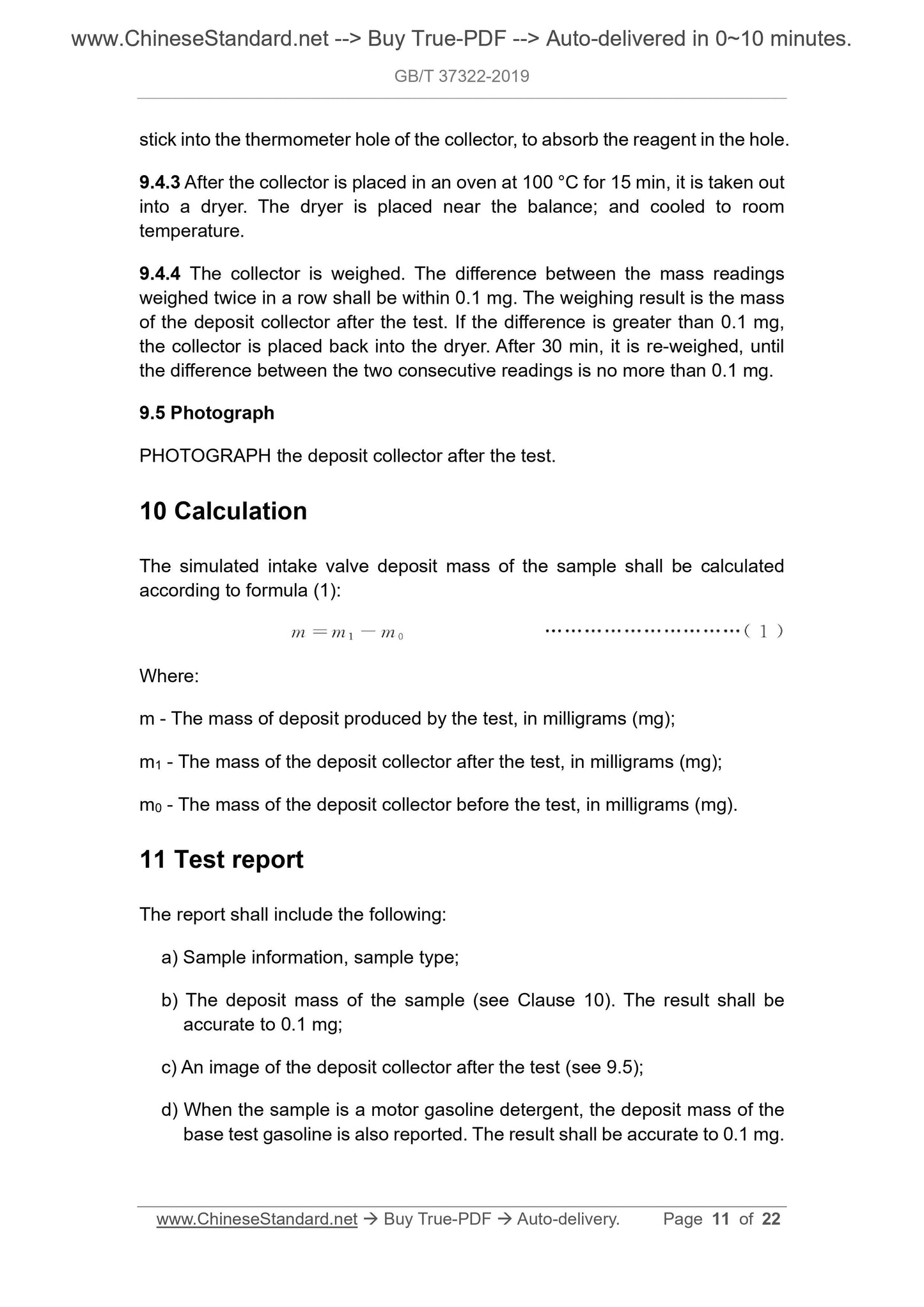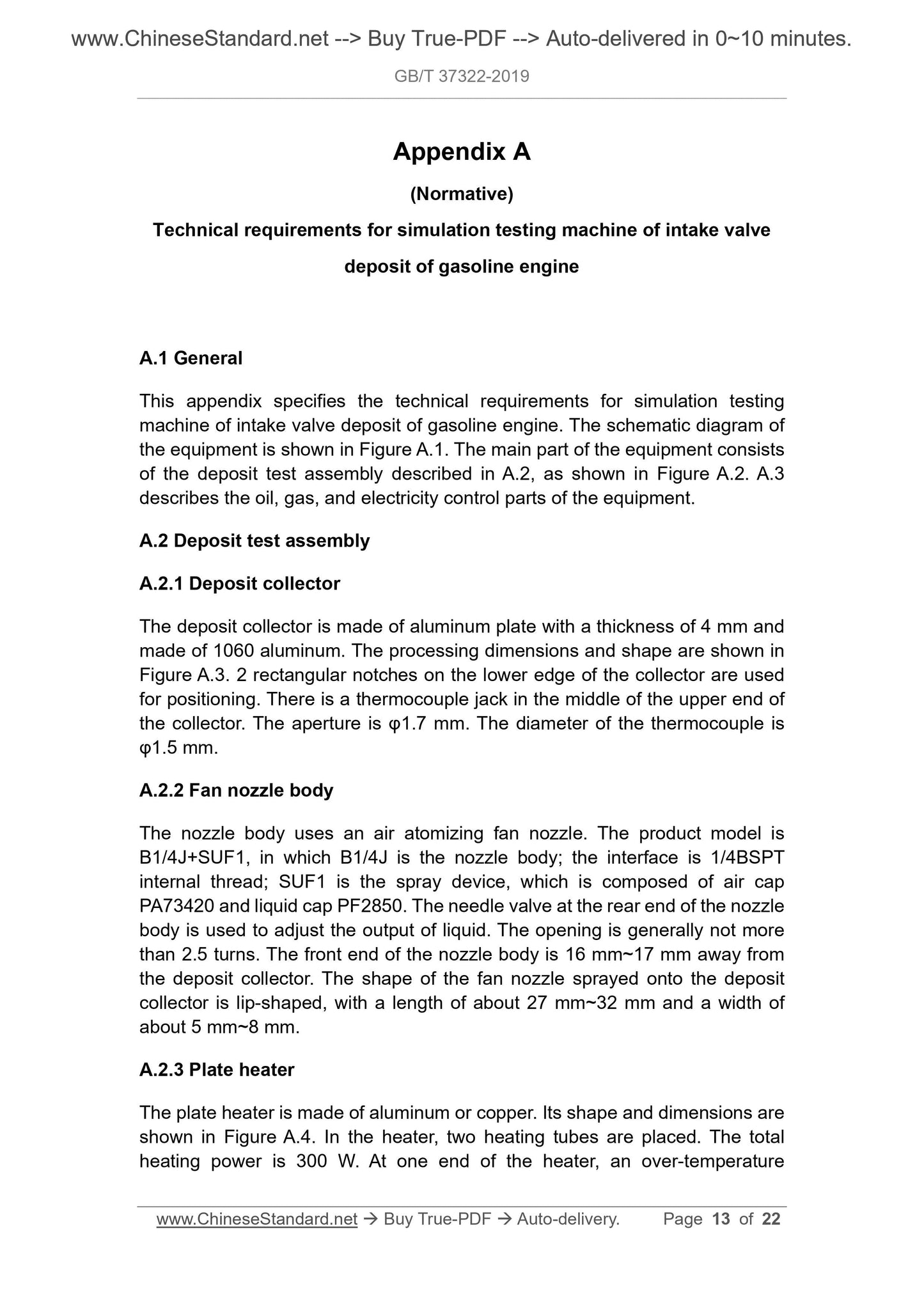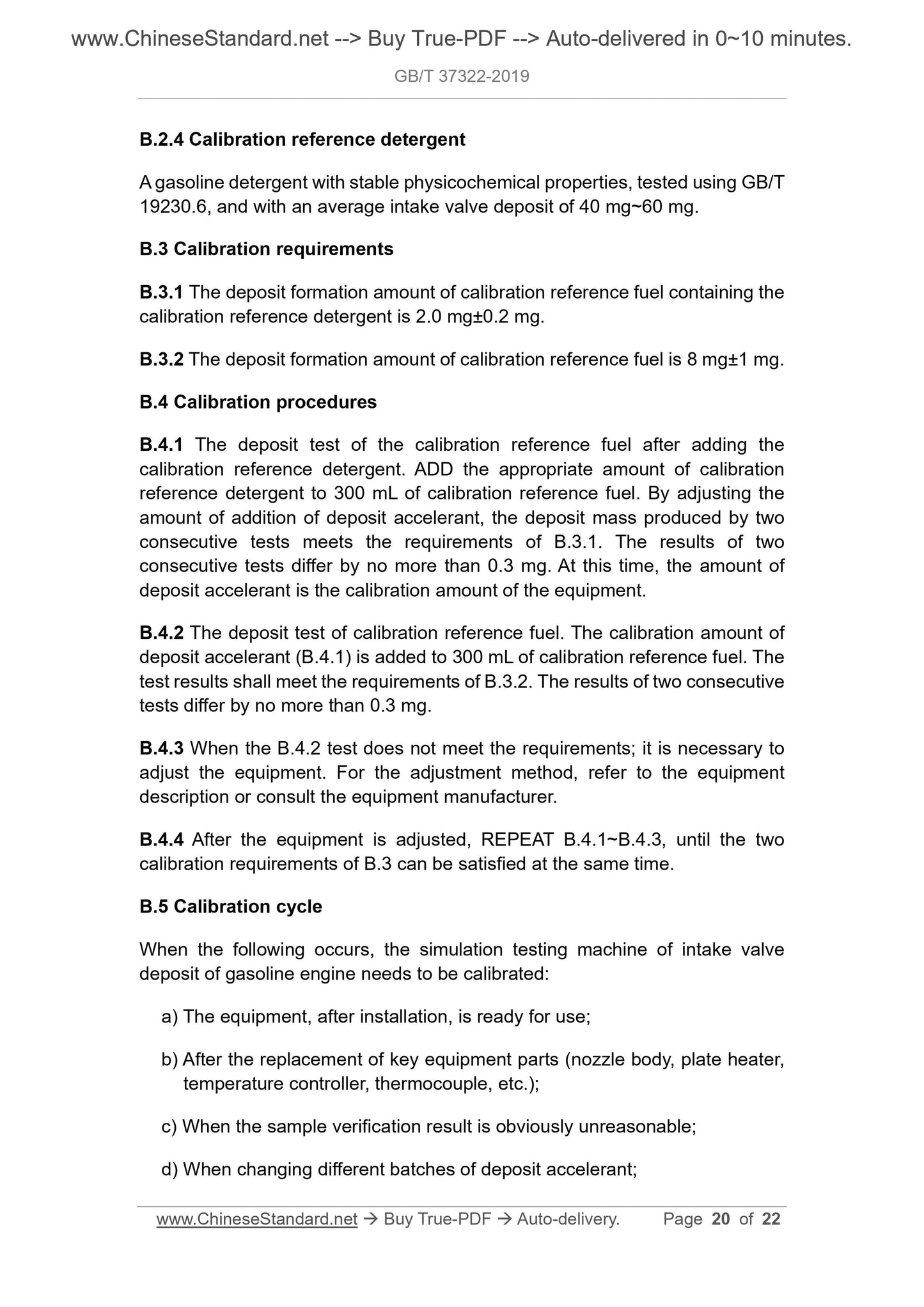1
/
of
8
www.ChineseStandard.us -- Field Test Asia Pte. Ltd.
GB/T 37322-2019 English PDF (GB/T37322-2019)
GB/T 37322-2019 English PDF (GB/T37322-2019)
Regular price
$265.00
Regular price
Sale price
$265.00
Unit price
/
per
Shipping calculated at checkout.
Couldn't load pickup availability
GB/T 37322-2019: Test method for evaluating gasoline cleanliness - Simulation test of intake valve deposit (IVD) of gasoline engine
Delivery: 9 seconds. Download (& Email) true-PDF + Invoice.
Get Quotation: Click GB/T 37322-2019 (Self-service in 1-minute)
Historical versions (Master-website): GB/T 37322-2019
Preview True-PDF (Reload/Scroll-down if blank)
GB/T 37322-2019
NATIONAL STANDARD OF THE
PEOPLE’S REPUBLIC OF CHINA
ICS 75.160.20
E 31
Test method for evaluating gasoline cleanliness -
Simulation test of intake valve deposit (IVD) of
gasoline engine
ISSUED ON: MARCH 25, 2019
IMPLEMENTED ON: OCTOBER 01, 2019
Issued by: State Administration for Market Regulation;
Standardization Administration of the PRC.
Table of Contents
Foreword ... 3
Introduction ... 4
1 Scope ... 5
2 Normative references ... 5
3 Terms and definitions ... 6
4 Method summary ... 6
5 Instruments and equipment ... 6
6 Reagents and materials ... 7
7 Sampling ... 8
8 Preparatory work ... 8
9 Test procedures ... 10
10 Calculation ... 11
11 Test report ... 11
12 Precision and deviation ... 12
Appendix A (Normative) Technical requirements for simulation testing machine
of intake valve deposit of gasoline engine ... 13
Appendix B (Normative) Equipment verification ... 19
Bibliography ... 22
Test method for evaluating gasoline cleanliness -
Simulation test of intake valve deposit (IVD) of
gasoline engine
Caution —— This Standard covers certain hazardous materials,
operations, and equipment, but does not make recommendations for all
safety problems. Therefore, users, before using this Standard, shall
establish appropriate safety precautions; and determine the applicability
of the relevant regulatory restrictions.
1 Scope
This Standard specifies the simulation test method of the intake valve deposit
of the inlet jet gasoline engine, is used for evaluating the tendency of the
formation of intake valve deposit of gasoline engine.
This Standard applies to motor gasoline and motor gasoline detergent.
Note: The test conditions for the application of this Standard to motor ethanol gasoline
have not been determined. Further investigations of the engine correlation are
required.
2 Normative references
The following documents are indispensable for the application of this document.
For the dated references, only the editions with the dates indicated are
applicable to this document. For the undated references, the latest edition
(including all the amendments) are applicable to this document.
GB/T 4756 Method for manual sampling of petroleum liquids
GB 17930 Gasoline for motor vehicles
GB/T 19230.6 Test method for evaluating gasoline detergent in use - Part 6:
Engine dynamometer test method for influence of intake valve and
combustion chamber deposit tendencies of gasoline detergent (M111
method)
5.2.2 Dryer: It contains a desiccant.
5.2.3 Oven: The temperature can be controlled at 100 °C±2 °C.
5.2.4 Micro sample injector: 1000 μL, 250 μL.
5.2.5 Volumetric flask: 300 mL.
5.2.6 Tweezers.
5.2.7 Balance gloves.
5.2.8 Digital camera: no less than 8 million pixels.
6 Reagents and materials
6.1 Reagents
6.1.1 N-heptane: analytically pure.
6.1.2 Petroleum ether: 60 °C~90 °C and 90 °C~120 °C, analytically pure.
6.1.3 Xylene: analytically pure.
6.1.4 Trimethylbenzene: industrial grade.
6.1.5 Tetramethylbenzene: industrial grade.
6.1.6 Anhydrous ethanol: analytically pure.
6.1.7 Isopropanol: analytically pure.
6.2 Materials
6.2.1 Scouring pad: particle size 240~280.
Note: The 3M 8698 scouring pad complies with the use requirements of this method.
6.2.2 Water sandpaper: 62 μm.
6.2.3 Deposit accelerant: See the requirements of B.2.1 in Appendix B.
6.2.4 Iron naphthenate diluent: See B.2.2.
6.2.5 Calibration reference fuel: The composition requirements are shown in
Table B.1.
6.2.6 Calibration reference detergent: See the requirements of B.2.4.
back into the dryer; and after 10 s, is weighed again. If the difference between
the two consecutive readings of weighing balance is no more than 0.1 mg, it
can be used as a stand-by. If the difference is greater than 0.1 mg, the collector
is placed back into the dryer. After 30 min, it is re-weighed, until the difference
between the two consecutive readings is no more than 0.1 mg.
Note: The spare collector cannot be touched directly with bare hands and
can be picked-placed with gloves worn.
8.2 Preparation of test equipment
8.2.1 The test time of the instrument is set to 85 min. The oil injection time is
set to 75 min. The test temperature is set to 175 °C (When the room
temperature is ≤20 °C, the temperature is set to 174 °C). The temperature
control accuracy is ±1 °C. TURN on the air source; adjust the air pressure to 80
kPa±1 kPa, and the air flow rate to 700 L/h±20 L/h.
8.2.2 POUR 30 mL of the mixed solution (The volume ratio of n-heptane to
xylene is 2:1) into the sample cup; REMOVE the sponge at the oil inlet of the
sample cup cap; then COVER the sample cup.
8.2.3 After using the mixed solution to thoroughly clean the inner wall of the
sample cup, PLACE the solvent recovery box in front of the nozzle; CLOSE the
cap of test hood.
8.2.4 TURN on the power switch of the equipment. USE the cleaning mode to
quickly spray the solution in the sample cup through the oil inlet hose and nozzle
to the solvent recovery box, until the spray is completed.
8.2.5 Continue to blow for about 3 min, to dry the line; END the cleaning mode;
SWITCH to the test mode; TAKE out the solvent recovery box. At the oil inlet, a
new sponge is replaced.
Note: When putting in and taking out the solvent recovery box, it shall
avoid touching the fuel spray nozzle.
8.2.6 Adjustment of peristaltic pump: The rate of the metering pump varies
depending on the ambient temperature at the time of the test. Adjust the rate of
peristaltic pump, so that 300 mL of oil is sprayed within 73 min~75 min.
8.3 Equipment verification
According to Appendix B, the simulation testing machine of intake valve deposit
of gasoline engine is verified.
stick into the thermometer hole of the collector, to absorb the reagent in the hole.
9.4.3 After the collector is placed in an oven at 100 °C for 15 min, it is taken out
into a dryer. The dryer is placed near the balance; and cooled to room
temperature.
9.4.4 The collector is weighed. The difference between the mass readings
weighed twice in a row shall be within 0.1 mg. The weighing result is the mass
of the deposit collector after the test. If the difference is greater than 0.1 mg,
the collector is placed back into the dryer. After 30 min, it is re-weighed, until
the difference between the two consecutive readings is no more than 0.1 mg.
9.5 Photograph
PHOTOGRAPH the deposit collector after the test.
10 Calculation
The simulated intake valve deposit mass of the sample shall be calculated
according to formula (1):
Where:
m - The mass of deposit produced by the test, in milligrams (mg);
m1 - The mass of the deposit collector after the test, in milligrams (mg);
m0 - The mass of the deposit collector before the test, in milligrams (mg).
11 Test report
The report shall include the following:
a) Sample information, sample type;
b) The deposit mass of the sample (see Clause 10). The result shall be
accurate to 0.1 mg;
c) An image of the deposit collector after the test (see 9.5);
d) When the sample is a motor gasoline detergent, the deposit mass of the
base test gasoline is also reported. The result shall be accurate to 0.1 mg.
Appendix A
(Normative)
Technical requirements for simulation testing machine of intake valve
deposit of gasoline engine
A.1 General
This appendix specifies the technical requirements for simulation testing
machine of intake valve deposit of gasoline engine. The schematic diagram of
the equipment is shown in Figure A.1. The main part of the equipment consists
of the deposit test assembly described in A.2, as shown in Figure A.2. A.3
describes the oil, gas, and electricity control parts of the equipment.
A.2 Deposit test assembly
A.2.1 Deposit collector
The deposit collector is made of aluminum plate with a thickness of 4 mm and
made of 1060 aluminum. The processing dimensions and shape are shown in
Figure A.3. 2 rectangular notches on the lower edge of the collector are used
for positioning. There is a thermocouple jack in the middle of the upper end of
the collector. The aperture is φ1.7 mm. The diameter of the thermocouple is
φ1.5 mm.
A.2.2 Fan nozzle body
The nozzle body uses an air atomizing fan nozzle. The product model is
B1/4J+SUF1, in which B1/4J is the nozzle body; the interface is 1/4BSPT
internal thread; SUF1 is the spray device, which is composed of air cap
PA73420 and liquid cap PF2850. The needle valve at the rear end of the nozzle
body is used to adjust the output of liquid. The opening is generally not more
than 2.5 turns. The front end of the nozzle body is 16 mm~17 mm away from
the deposit collector. The shape of the fan nozzle sprayed onto the deposit
collector is lip-shaped, with a length of about 27 mm~32 mm and a width of
about 5 mm~8 mm.
A.2.3 Plate heater
The plate heater is made of aluminum or copper. Its shape and dimensions are
shown in Figure A.4. In the heater, two heating tubes are placed. The total
heating power is 300 W. At one end of the heater, an over-temperature
B.2.4 Calibration reference detergent
A gasoline detergent with stable physicochemical properties, tested using GB/T
19230.6, and with an average intake valve deposit of 40 mg~60 mg.
B.3 Calibration requirements
B.3.1 The deposit formation amount of calibration reference fuel containing the
calibration reference detergent is 2.0 mg±0.2 mg.
B.3.2 The deposit formation amount of calibration reference fuel is 8 mg±1 mg.
B.4 Calibration procedures
B.4.1 The deposit test of the calibration reference fuel after adding the
calibration reference detergent. ADD the appropriate amount of calibration
reference detergent to 300 mL of calibration reference fuel. By adjusting the
amount of addition of deposit accelerant, the deposit mass produced by two
consecutive tests meets the requirements of B.3.1. The results of two
consecutive tests differ by no more than 0.3 mg. At this time, the amount of
deposit accelerant is the calibration amount of the equipment.
B.4.2 The deposit test of calibration reference fuel. The calibration amount of
deposit accelerant (B.4.1) is added to 300 mL of calibration reference fuel. The
test results shall meet the requirements of B.3.2. The results of two consecutive
tests differ by no more than 0.3 mg.
B.4.3 When the B.4.2 test does not meet the requirements; it is necessary to
adjust the equipment. For the adjustment method, refer to the equipment
description or consult the equipment manufacturer.
B.4.4 After the equipment is adjusted, REPEAT B.4.1~B.4.3, until the two
calibration requirements of B.3 can be satisfied at the same time.
B.5 Calibration cycle
When the following occurs, the simulation testing machine of intake valve
deposit of gasoline engine needs to be calibrated:
a) The equipment, after installation, is ready for use;
b) After the replacement of key equipment parts (nozzle body, plate heater,
temperature controller, thermocouple, etc.);
c) When the sample verification result is obviously unreasonable;
d) When changing different batches of deposit accelerant;
GB/T 37322-2019
NATIONAL STANDARD OF THE
PEOPLE’S REPUBLIC OF CHINA
ICS 75.160.20
E 31
Test method for evaluating gasoline cleanliness -
Simulation test of intake valve deposit (IVD) of
gasoline engine
ISSUED ON: MARCH 25, 2019
IMPLEMENTED ON: OCTOBER 01, 2019
Issued by: State Administration for Market Regulation;
Standardization Administration of the PRC.
Table of Contents
Foreword ... 3
Introduction ... 4
1 Scope ... 5
2 Normative references ... 5
3 Terms and definitions ... 6
4 Method summary ... 6
5 Instruments and equipment ... 6
6 Reagents and materials ... 7
7 Sampling ... 8
8 Preparatory work ... 8
9 Test procedures ... 10
10 Calculation ... 11
11 Test report ... 11
12 Precision and deviation ... 12
Appendix A (Normative) Technical requirements for simulation testing machine
of intake valve deposit of gasoline engine ... 13
Appendix B (Normative) Equipment verification ... 19
Bibliography ... 22
Test method for evaluating gasoline cleanliness -
Simulation test of intake valve deposit (IVD) of
gasoline engine
Caution —— This Standard covers certain hazardous materials,
operations, and equipment, but does not make recommendations for all
safety problems. Therefore, users, before using this Standard, shall
establish appropriate safety precautions; and determine the applicability
of the relevant regulatory restrictions.
1 Scope
This Standard specifies the simulation test method of the intake valve deposit
of the inlet jet gasoline engine, is used for evaluating the tendency of the
formation of intake valve deposit of gasoline engine.
This Standard applies to motor gasoline and motor gasoline detergent.
Note: The test conditions for the application of this Standard to motor ethanol gasoline
have not been determined. Further investigations of the engine correlation are
required.
2 Normative references
The following documents are indispensable for the application of this document.
For the dated references, only the editions with the dates indicated are
applicable to this document. For the undated references, the latest edition
(including all the amendments) are applicable to this document.
GB/T 4756 Method for manual sampling of petroleum liquids
GB 17930 Gasoline for motor vehicles
GB/T 19230.6 Test method for evaluating gasoline detergent in use - Part 6:
Engine dynamometer test method for influence of intake valve and
combustion chamber deposit tendencies of gasoline detergent (M111
method)
5.2.2 Dryer: It contains a desiccant.
5.2.3 Oven: The temperature can be controlled at 100 °C±2 °C.
5.2.4 Micro sample injector: 1000 μL, 250 μL.
5.2.5 Volumetric flask: 300 mL.
5.2.6 Tweezers.
5.2.7 Balance gloves.
5.2.8 Digital camera: no less t...
Delivery: 9 seconds. Download (& Email) true-PDF + Invoice.
Get Quotation: Click GB/T 37322-2019 (Self-service in 1-minute)
Historical versions (Master-website): GB/T 37322-2019
Preview True-PDF (Reload/Scroll-down if blank)
GB/T 37322-2019
NATIONAL STANDARD OF THE
PEOPLE’S REPUBLIC OF CHINA
ICS 75.160.20
E 31
Test method for evaluating gasoline cleanliness -
Simulation test of intake valve deposit (IVD) of
gasoline engine
ISSUED ON: MARCH 25, 2019
IMPLEMENTED ON: OCTOBER 01, 2019
Issued by: State Administration for Market Regulation;
Standardization Administration of the PRC.
Table of Contents
Foreword ... 3
Introduction ... 4
1 Scope ... 5
2 Normative references ... 5
3 Terms and definitions ... 6
4 Method summary ... 6
5 Instruments and equipment ... 6
6 Reagents and materials ... 7
7 Sampling ... 8
8 Preparatory work ... 8
9 Test procedures ... 10
10 Calculation ... 11
11 Test report ... 11
12 Precision and deviation ... 12
Appendix A (Normative) Technical requirements for simulation testing machine
of intake valve deposit of gasoline engine ... 13
Appendix B (Normative) Equipment verification ... 19
Bibliography ... 22
Test method for evaluating gasoline cleanliness -
Simulation test of intake valve deposit (IVD) of
gasoline engine
Caution —— This Standard covers certain hazardous materials,
operations, and equipment, but does not make recommendations for all
safety problems. Therefore, users, before using this Standard, shall
establish appropriate safety precautions; and determine the applicability
of the relevant regulatory restrictions.
1 Scope
This Standard specifies the simulation test method of the intake valve deposit
of the inlet jet gasoline engine, is used for evaluating the tendency of the
formation of intake valve deposit of gasoline engine.
This Standard applies to motor gasoline and motor gasoline detergent.
Note: The test conditions for the application of this Standard to motor ethanol gasoline
have not been determined. Further investigations of the engine correlation are
required.
2 Normative references
The following documents are indispensable for the application of this document.
For the dated references, only the editions with the dates indicated are
applicable to this document. For the undated references, the latest edition
(including all the amendments) are applicable to this document.
GB/T 4756 Method for manual sampling of petroleum liquids
GB 17930 Gasoline for motor vehicles
GB/T 19230.6 Test method for evaluating gasoline detergent in use - Part 6:
Engine dynamometer test method for influence of intake valve and
combustion chamber deposit tendencies of gasoline detergent (M111
method)
5.2.2 Dryer: It contains a desiccant.
5.2.3 Oven: The temperature can be controlled at 100 °C±2 °C.
5.2.4 Micro sample injector: 1000 μL, 250 μL.
5.2.5 Volumetric flask: 300 mL.
5.2.6 Tweezers.
5.2.7 Balance gloves.
5.2.8 Digital camera: no less than 8 million pixels.
6 Reagents and materials
6.1 Reagents
6.1.1 N-heptane: analytically pure.
6.1.2 Petroleum ether: 60 °C~90 °C and 90 °C~120 °C, analytically pure.
6.1.3 Xylene: analytically pure.
6.1.4 Trimethylbenzene: industrial grade.
6.1.5 Tetramethylbenzene: industrial grade.
6.1.6 Anhydrous ethanol: analytically pure.
6.1.7 Isopropanol: analytically pure.
6.2 Materials
6.2.1 Scouring pad: particle size 240~280.
Note: The 3M 8698 scouring pad complies with the use requirements of this method.
6.2.2 Water sandpaper: 62 μm.
6.2.3 Deposit accelerant: See the requirements of B.2.1 in Appendix B.
6.2.4 Iron naphthenate diluent: See B.2.2.
6.2.5 Calibration reference fuel: The composition requirements are shown in
Table B.1.
6.2.6 Calibration reference detergent: See the requirements of B.2.4.
back into the dryer; and after 10 s, is weighed again. If the difference between
the two consecutive readings of weighing balance is no more than 0.1 mg, it
can be used as a stand-by. If the difference is greater than 0.1 mg, the collector
is placed back into the dryer. After 30 min, it is re-weighed, until the difference
between the two consecutive readings is no more than 0.1 mg.
Note: The spare collector cannot be touched directly with bare hands and
can be picked-placed with gloves worn.
8.2 Preparation of test equipment
8.2.1 The test time of the instrument is set to 85 min. The oil injection time is
set to 75 min. The test temperature is set to 175 °C (When the room
temperature is ≤20 °C, the temperature is set to 174 °C). The temperature
control accuracy is ±1 °C. TURN on the air source; adjust the air pressure to 80
kPa±1 kPa, and the air flow rate to 700 L/h±20 L/h.
8.2.2 POUR 30 mL of the mixed solution (The volume ratio of n-heptane to
xylene is 2:1) into the sample cup; REMOVE the sponge at the oil inlet of the
sample cup cap; then COVER the sample cup.
8.2.3 After using the mixed solution to thoroughly clean the inner wall of the
sample cup, PLACE the solvent recovery box in front of the nozzle; CLOSE the
cap of test hood.
8.2.4 TURN on the power switch of the equipment. USE the cleaning mode to
quickly spray the solution in the sample cup through the oil inlet hose and nozzle
to the solvent recovery box, until the spray is completed.
8.2.5 Continue to blow for about 3 min, to dry the line; END the cleaning mode;
SWITCH to the test mode; TAKE out the solvent recovery box. At the oil inlet, a
new sponge is replaced.
Note: When putting in and taking out the solvent recovery box, it shall
avoid touching the fuel spray nozzle.
8.2.6 Adjustment of peristaltic pump: The rate of the metering pump varies
depending on the ambient temperature at the time of the test. Adjust the rate of
peristaltic pump, so that 300 mL of oil is sprayed within 73 min~75 min.
8.3 Equipment verification
According to Appendix B, the simulation testing machine of intake valve deposit
of gasoline engine is verified.
stick into the thermometer hole of the collector, to absorb the reagent in the hole.
9.4.3 After the collector is placed in an oven at 100 °C for 15 min, it is taken out
into a dryer. The dryer is placed near the balance; and cooled to room
temperature.
9.4.4 The collector is weighed. The difference between the mass readings
weighed twice in a row shall be within 0.1 mg. The weighing result is the mass
of the deposit collector after the test. If the difference is greater than 0.1 mg,
the collector is placed back into the dryer. After 30 min, it is re-weighed, until
the difference between the two consecutive readings is no more than 0.1 mg.
9.5 Photograph
PHOTOGRAPH the deposit collector after the test.
10 Calculation
The simulated intake valve deposit mass of the sample shall be calculated
according to formula (1):
Where:
m - The mass of deposit produced by the test, in milligrams (mg);
m1 - The mass of the deposit collector after the test, in milligrams (mg);
m0 - The mass of the deposit collector before the test, in milligrams (mg).
11 Test report
The report shall include the following:
a) Sample information, sample type;
b) The deposit mass of the sample (see Clause 10). The result shall be
accurate to 0.1 mg;
c) An image of the deposit collector after the test (see 9.5);
d) When the sample is a motor gasoline detergent, the deposit mass of the
base test gasoline is also reported. The result shall be accurate to 0.1 mg.
Appendix A
(Normative)
Technical requirements for simulation testing machine of intake valve
deposit of gasoline engine
A.1 General
This appendix specifies the technical requirements for simulation testing
machine of intake valve deposit of gasoline engine. The schematic diagram of
the equipment is shown in Figure A.1. The main part of the equipment consists
of the deposit test assembly described in A.2, as shown in Figure A.2. A.3
describes the oil, gas, and electricity control parts of the equipment.
A.2 Deposit test assembly
A.2.1 Deposit collector
The deposit collector is made of aluminum plate with a thickness of 4 mm and
made of 1060 aluminum. The processing dimensions and shape are shown in
Figure A.3. 2 rectangular notches on the lower edge of the collector are used
for positioning. There is a thermocouple jack in the middle of the upper end of
the collector. The aperture is φ1.7 mm. The diameter of the thermocouple is
φ1.5 mm.
A.2.2 Fan nozzle body
The nozzle body uses an air atomizing fan nozzle. The product model is
B1/4J+SUF1, in which B1/4J is the nozzle body; the interface is 1/4BSPT
internal thread; SUF1 is the spray device, which is composed of air cap
PA73420 and liquid cap PF2850. The needle valve at the rear end of the nozzle
body is used to adjust the output of liquid. The opening is generally not more
than 2.5 turns. The front end of the nozzle body is 16 mm~17 mm away from
the deposit collector. The shape of the fan nozzle sprayed onto the deposit
collector is lip-shaped, with a length of about 27 mm~32 mm and a width of
about 5 mm~8 mm.
A.2.3 Plate heater
The plate heater is made of aluminum or copper. Its shape and dimensions are
shown in Figure A.4. In the heater, two heating tubes are placed. The total
heating power is 300 W. At one end of the heater, an over-temperature
B.2.4 Calibration reference detergent
A gasoline detergent with stable physicochemical properties, tested using GB/T
19230.6, and with an average intake valve deposit of 40 mg~60 mg.
B.3 Calibration requirements
B.3.1 The deposit formation amount of calibration reference fuel containing the
calibration reference detergent is 2.0 mg±0.2 mg.
B.3.2 The deposit formation amount of calibration reference fuel is 8 mg±1 mg.
B.4 Calibration procedures
B.4.1 The deposit test of the calibration reference fuel after adding the
calibration reference detergent. ADD the appropriate amount of calibration
reference detergent to 300 mL of calibration reference fuel. By adjusting the
amount of addition of deposit accelerant, the deposit mass produced by two
consecutive tests meets the requirements of B.3.1. The results of two
consecutive tests differ by no more than 0.3 mg. At this time, the amount of
deposit accelerant is the calibration amount of the equipment.
B.4.2 The deposit test of calibration reference fuel. The calibration amount of
deposit accelerant (B.4.1) is added to 300 mL of calibration reference fuel. The
test results shall meet the requirements of B.3.2. The results of two consecutive
tests differ by no more than 0.3 mg.
B.4.3 When the B.4.2 test does not meet the requirements; it is necessary to
adjust the equipment. For the adjustment method, refer to the equipment
description or consult the equipment manufacturer.
B.4.4 After the equipment is adjusted, REPEAT B.4.1~B.4.3, until the two
calibration requirements of B.3 can be satisfied at the same time.
B.5 Calibration cycle
When the following occurs, the simulation testing machine of intake valve
deposit of gasoline engine needs to be calibrated:
a) The equipment, after installation, is ready for use;
b) After the replacement of key equipment parts (nozzle body, plate heater,
temperature controller, thermocouple, etc.);
c) When the sample verification result is obviously unreasonable;
d) When changing different batches of deposit accelerant;
GB/T 37322-2019
NATIONAL STANDARD OF THE
PEOPLE’S REPUBLIC OF CHINA
ICS 75.160.20
E 31
Test method for evaluating gasoline cleanliness -
Simulation test of intake valve deposit (IVD) of
gasoline engine
ISSUED ON: MARCH 25, 2019
IMPLEMENTED ON: OCTOBER 01, 2019
Issued by: State Administration for Market Regulation;
Standardization Administration of the PRC.
Table of Contents
Foreword ... 3
Introduction ... 4
1 Scope ... 5
2 Normative references ... 5
3 Terms and definitions ... 6
4 Method summary ... 6
5 Instruments and equipment ... 6
6 Reagents and materials ... 7
7 Sampling ... 8
8 Preparatory work ... 8
9 Test procedures ... 10
10 Calculation ... 11
11 Test report ... 11
12 Precision and deviation ... 12
Appendix A (Normative) Technical requirements for simulation testing machine
of intake valve deposit of gasoline engine ... 13
Appendix B (Normative) Equipment verification ... 19
Bibliography ... 22
Test method for evaluating gasoline cleanliness -
Simulation test of intake valve deposit (IVD) of
gasoline engine
Caution —— This Standard covers certain hazardous materials,
operations, and equipment, but does not make recommendations for all
safety problems. Therefore, users, before using this Standard, shall
establish appropriate safety precautions; and determine the applicability
of the relevant regulatory restrictions.
1 Scope
This Standard specifies the simulation test method of the intake valve deposit
of the inlet jet gasoline engine, is used for evaluating the tendency of the
formation of intake valve deposit of gasoline engine.
This Standard applies to motor gasoline and motor gasoline detergent.
Note: The test conditions for the application of this Standard to motor ethanol gasoline
have not been determined. Further investigations of the engine correlation are
required.
2 Normative references
The following documents are indispensable for the application of this document.
For the dated references, only the editions with the dates indicated are
applicable to this document. For the undated references, the latest edition
(including all the amendments) are applicable to this document.
GB/T 4756 Method for manual sampling of petroleum liquids
GB 17930 Gasoline for motor vehicles
GB/T 19230.6 Test method for evaluating gasoline detergent in use - Part 6:
Engine dynamometer test method for influence of intake valve and
combustion chamber deposit tendencies of gasoline detergent (M111
method)
5.2.2 Dryer: It contains a desiccant.
5.2.3 Oven: The temperature can be controlled at 100 °C±2 °C.
5.2.4 Micro sample injector: 1000 μL, 250 μL.
5.2.5 Volumetric flask: 300 mL.
5.2.6 Tweezers.
5.2.7 Balance gloves.
5.2.8 Digital camera: no less t...
Share
